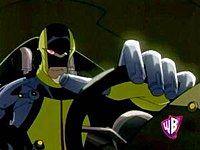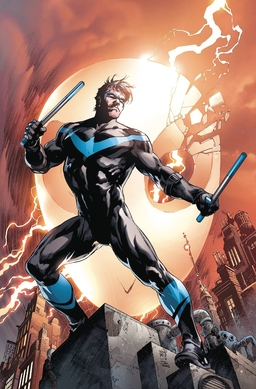
Nightwing is a superhero appearing in American comic books published by DC Comics. The character has appeared in various incarnations; the identity is adopted by Dick Grayson when he leaves his role as Batman's partner and sidekick Robin.

Richard John "Dick" Grayson is a fictional superhero appearing in American comic books published by DC Comics, commonly in association with Batman and Teen Titans. Created by writer Bill Finger and artist Bob Kane, he first appeared in Detective Comics #38 in April 1940 as the original and most popular incarnation of Robin, Batman's crime-fighting partner. In Tales of the Teen Titans #44, the character, after becoming a young adult, retires his role as Robin and assumes the superhero persona of Nightwing.

Clayface is an alias used by several supervillains appearing in American comic books published by DC Comics. Most incarnations of the character possess clay-like bodies and shapeshifting abilities, and all of them are adversaries of the superhero Batman. In 2009, Clayface was ranked as IGN's 73rd-greatest comic book villain of all time.

Jason Peter Todd is a character appearing in American comic books published by DC Comics. First appearing in Batman #357 in March 1983, he was created to succeed Dick Grayson as Robin, Batman's partner and sidekick. Initially sharing a similar origin to Grayson, his character's origin was rewritten after the Crisis on Infinite Earths event. Subsequent portrayals commonly depict Todd as an orphaned street delinquent with a troubled past and a violent demeanor, whom Batman attempts to reform and mentor.
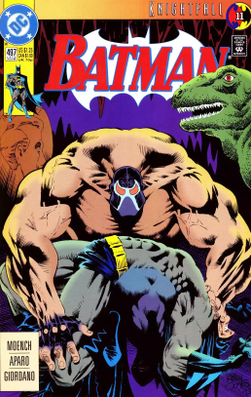
"Knightfall" is a 1993–1994 Batman story arc published by DC Comics. It consists of a trilogy of storylines that ran from 1993 to 1994, consisting of "Knightfall", "Knightquest", and "KnightsEnd".

Firefly is a supervillain appearing in American comic books published by DC Comics. Created by France Herron and Dick Sprang, he made his debut in Detective Comics #184. Initially portrayed as a criminal who utilized lighting effects to commit robberies, Firefly was later reimagined as a sociopathic pyromaniac with an obsessive compulsion to start fires following Crisis on Infinite Earths' reboot of the DC Universe in the 1980s. This darker depiction of the character has since endured as one of the superhero Batman's most recurring enemies and belongs to the collective of adversaries that make up his central rogues gallery.
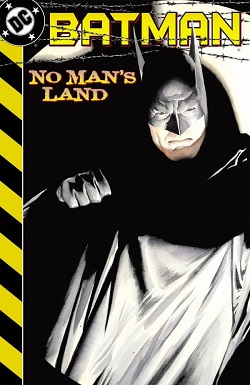
"Batman: No Man's Land" is an American comic book crossover storyline that ran for almost all of 1999 through the Batman comic book titles published by DC Comics. The story architecture for "No Man's Land" and the outline of all the Batman continuity titles for 1999 were written by cartoonist Jordan B. Gorfinkel.

Hush is a supervillain appearing in American comic books published by DC Comics. Created by Jeph Loeb and Jim Lee, the character first appeared in Batman #609 in January 2003 as part of the twelve-issue storyline Batman: Hush. Hush serves as a criminal foil to the superhero Batman and belongs to the collective of adversaries that make up his rogues gallery.
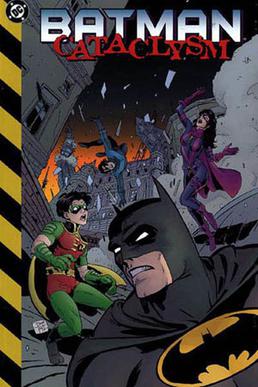
Cataclysm is an 18-chapter DC Comics crossover story arc that ran through the various Batman family comics from March to May 1998. The plot of the storyline centers on Gotham City being hit by a massive earthquake, the epicenter of which is less than a mile from Wayne Manor. In the wake of the destruction, Batman and his allies join the frantic rescue efforts around the devastated city, which soon spirals into chaos. This story arc would act as a catalyst for the Batman comics and its spin-off titles, signaling the beginning of nearly two years of storylines that would spring forth in the earthquake's aftermath, culminating in the year-long Batman: No Man's Land saga. Cataclysm itself takes place a short time after the events of Batman: Contagion and Batman: Legacy, two previous crises which also nearly resulted in Gotham City's destruction.

"Bruce Wayne: Fugitive" is a storyline that ran through the Batman comic books in 2002. The story directly follows the "Bruce Wayne: Murderer?" story.
Anthony Zucco is a fictional character appearing in American comic books published by DC Comics. First appearing in Detective Comics #38, Zucco is a mobster responsible for murdering the parents of Dick Grayson, which leads to Grayson's adoption by Bruce Wayne a.k.a. Batman and becoming the latter's sidekick and original Robin and Nightwing.

The Batcycle, Batblade, or Batpod is the fictional personal motorcycle of the DC Comics superhero Batman. In the comic book universe, Batman's personal Batcycle is a modified street-bike with a 786 cc liquid-cooled V-4 engine. It contains a computer-controlled carburetor and bulletproof wind-guard.
Joker: Last Laugh is a crossover storyline published by DC Comics in 2001.
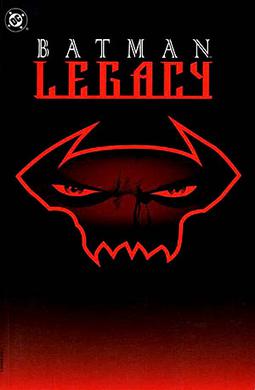
Legacy is a crossover story arc in the Batman comic book series, which is a sequel to another Batman story arc, Contagion and also serves as a follow-up to the Knightfall story arc.
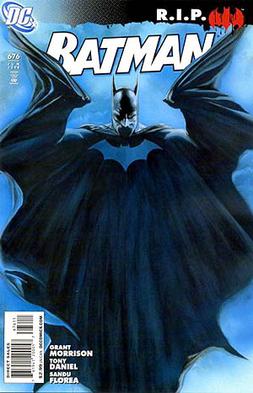
Batman R.I.P. is an American comic book story arc published in Batman #676–681 by DC Comics. Written by Grant Morrison, penciled by Tony Daniel, and with covers by Alex Ross, the story pits the superhero Batman against the Black Glove organization as they attempt to destroy everything that he stands for. It has a number of tie-ins in other DC Comics titles describing events not told in the main story.

Mr. Freeze is a supervillain appearing in American comic books published by DC Comics. Created by Dave Wood, Sheldon Moldoff and Bob Kane, the character first appeared in Batman #121 as the ice-based criminal Mr. Zero. He was soon renamed "Mr. Freeze" and, years later, received a revamped origin story based on the one conceived by writer Paul Dini for Batman: The Animated Series. Dini's depiction of the character as a tragic villain popularized Mr. Freeze into becoming one of Batman's most enduring enemies belonging to the collective of adversaries that make up his rogues gallery.
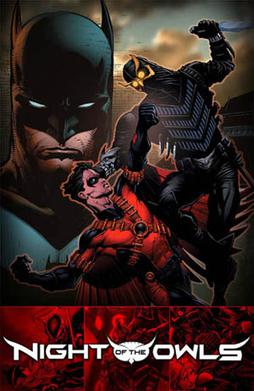
"Batman: Night of the Owls" is a comic book crossover storyline published by DC Comics in mid-2012, and featuring the Batman family of characters. Primarily written by Scott Snyder, the arc is the first major crossover storyline of The New 52.

The Court of Owls is a criminal organization and secret society appearing in American comic books published by DC Comics. They appear as adversaries of the superhero Batman. Created by writer Scott Snyder and artist Greg Capullo, the Court is described as an organization of the wealthiest and most influential citizens of the city of Gotham, having existed since the city's founding and completely unknown among its general population outside of an urban legend centered around their reputation for grisly assassinations carried out by indoctrinated agents known as Talons. The 2015–2016 "Robin War" story line details their international expansion, with the group renaming itself the Parliament of Owls.
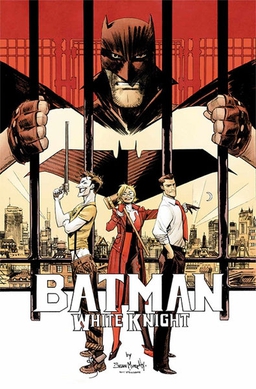
Batman: White Knight is an American comic book published by DC Comics. The eight-issue limited series, written and illustrated by Sean Murphy, began monthly publication in October 2017 and concluded in May 2018. In the series, the Joker is seemingly cured of his madness and sets out to become a politician under his real name of Jack Napier, seeking to change his public image as a "villain" and save Gotham City from Batman, whom he views as the real enemy of the city.
"Shadows of the Bat" is a 12-issue weekly comic book event published in December 2021, mainly set in the Detective Comics series. Set after "Fear State", the storyline features the Bat-Family dealing with a new villain and Arkham Tower being created in Gotham City. The event received positive reviews from critics who praised the action, story, and art.
